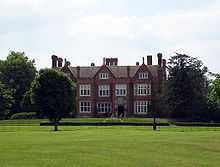Patrick Steptoe
| Patrick Steptoe | |
|---|---|
 | |
| Born |
Patrick Christopher Steptoe 9 June 1913 Oxford, England |
| Died |
21 March 1988 (aged 74) Canterbury |
| Education |
King's College London St George's Hospital Medical School |
| Years active | 1939-1988 |
| Known for | Development of in vitro fertilization |
| Medical career | |
| Profession | Physician |
| Institutions |
Oldham General Hospital Bourn Hall Clinic |
| Specialism | obstetrics and gynaecology |
| Research | in vitro fertilization |
| Notable prizes | Fellow of the Royal Society[1] |

Patrick Christopher Steptoe CBE FRS[1] (9 June 1913, Oxford, England – 21 March 1988, Canterbury) was a British obstetrician and gynaecologist and a pioneer of fertility treatment. Steptoe was responsible with biologist and physiologist Robert Edwards for developing in vitro fertilization. Louise Joy Brown, the first test-tube baby, was born on 25 July 1978.[2][3] Edwards was awarded the 2010 Nobel Prize in Physiology or Medicine for his work on the development of in vitro fertilization, however because the Nobel Prize is not awarded posthumously, Steptoe was not eligible for consideration.[4]
Education
Steptoe was educated at The Grammar School, Witney (since 1968 the comprehensive Henry Box School) in Oxfordshire. He went to King's College London and graduated from St George's Hospital Medical School, London in 1939.
Laparoscopy pioneer
After the Second World War, he studied obstetrics and, in 1951 he started to work at the Oldham General Hospital. From Mr. Raoul Palmer he learned the technique of laparoscopy and promoted its usefulness. In 1967 he published a book on Laparoscopy in Gynaecology. Subsequently, Robert Edwards, a physiologist from the University of Cambridge, contacted him and got him interested to collaborate in the development of in vitro fertilization.
Work with Edwards
Steptoe became the Director of the Centre for Human Reproduction, Oldham in 1969. Using laparoscopy, he collected the ova from volunteering infertile women who saw his place as their last hope to achieve a pregnancy. Edwards and his assistant Jean Purdy provided the laboratory expertise. During this time they had to endure criticism and hostility to their work. Finally, in 1978, the birth of Louise Brown changed everything. Although he encountered further criticism, other clinics were able to follow the lead and patients responded. To accommodate the increased patient number and train specialists, he and Edwards founded the Bourn Hall Clinic, Cambridgeshire in 1980 of which he was a Medical Director until his death.
He was elected a Fellow of the Royal Society in March 1987 [1][5]
A plaque was unveiled at the Bourn Hall Clinic in July 2013 by Louise Brown and Alastair MacDonald - the world's first IVF baby boy - commemorating Steptoe and Edwards.[6][7] Steptoe is also commemorated with a plaque at the Maternity Ward at the Royal Oldham Hospital.[8]
References
- ↑ 1.0 1.1 1.2 Edwards, R. G. (1996). "Patrick Christopher Steptoe, C. B. E. 9 June 1913-22 March 1988". Biographical Memoirs of Fellows of the Royal Society 42: 434–426. doi:10.1098/rsbm.1996.0027.
- ↑ "1978: First 'test tube baby' born". BBC. 25 July 1978. Retrieved 2009-06-13. "The birth of the world's first "test tube baby" has been announced in Manchester (England). Louise Brown was born shortly before midnight in Oldham and District General Hospital"
- ↑ Moreton, Cole (14 January 2007). "World's first test-tube baby Louise Brown has a child of her own". London: Independent. Retrieved 21 May 2010. "The 28-year-old, whose pioneering conception by in-vitro fertilisation made her famous around the world. The fertility specialists Patrick Steptoe and Bob Edwards became the first to successfully carry out IVF by extracting an egg, impregnating it with sperm and planting the resulting embryo back into the mother"
- ↑ "The 2010 Nobel Prize in Physiology or Medicine - Press Release". Nobelprize.org. 2010-10-04. Retrieved 2010-10-04.
- ↑ "Library and Archive Catalogue". Royal Society. Retrieved 21 October 2010.
- ↑ http://www.oldham-chronicle.co.uk/news-features/8/news-headlines/81552/worlds-first-testtube-baby-hails-pioneers-on-35th-birthday
- ↑ http://www.bourn-hall-clinic.co.uk/news/35-years-of-ivf-celebrated-by-the-first-test-tube-baby-at-bourn-hall-clinic/
- ↑ http://www.oldham.gov.uk/info/200541/blue_plaques
Sources
- Litynski GS (1998). "Patrick C. Steptoe: laparoscopy, sterilization, the test-tube baby, and mass media". JSLS 2 (1): 99–101. PMC 3015256. PMID 9876723.
- Edwards RG (1996). "Patrick Christopher Steptoe, C.B.E.: 9 June 1913 - 22 March 1988". Biographical Memoirs of Fellows of the Royal Society. Royal Society 42: 435–52. PMID 11619339.
- "Dr. Steptoe's full report--at last". Medical World News 20 (4): 10–11+. February 1979. PMID 11645394.
- Weintraub RM (July 1978). "First test-tube baby born in British hospital". Washington Post: A1+. PMID 11648723.
- Gwynne P, Collings A, Gastel B (July 1978). "The test-tube baby". Newsweek 92 (4): 76. PMID 11662500.
- Nossiter B (July 1978). "Test tube baby 'well': doctors predict more successes". Washington Post: A1+. PMID 11648647.
- "By-passing a block to conception". Times: 15. July 1978. PMID 11648651.
- Hathout H (September 1978). "Test tube babies!". The Journal of the Kuwait Medical Association 12 (3): 135–6. PMID 11662645.
- Shearer L (October 1978). "Next: twin tube babies?". Parade: 23. PMID 12088000.
- Cohn V (October 1978). "Test-tube baby pioneer urges easing of curbs". Washington Post: A26. PMID 11648949.
- Hand GO (December 1978). "The manipulation of existence: conceiving the inconceivable". Vital Speeches of the Day 45 (4): 98–102. PMID 11662640.
- "In vitro fertilization questions remain: no ethics problem, Dr. Steptoe says". American Medical News 22 (8): 1, 15–6. February 1979. PMID 10315865.
- "That baby again". Time 113 (8): 82. February 1979. PMID 11665072.
- Edwards RG (1996). "The history of assisted human conception with especial reference to endocrinology". Experimental and Clinical Endocrinology & Diabetes 104 (3): 183–204. doi:10.1055/s-0029-1211443. PMID 8817236.
|